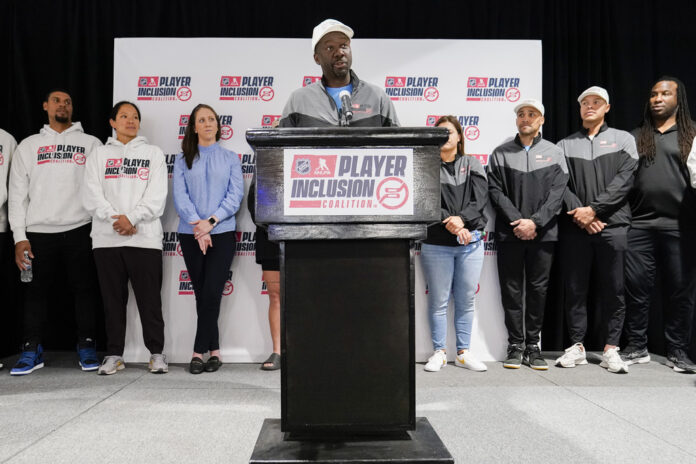
The NHL and NHLPA launched a new inclusion committee Tuesday that is made up of current and former men’s and women’s players, with minority and LGBTQ+ representation, aimed at diversifying hockey and making the sport more welcoming.
The NHL Player Inclusion Coalition is the latest step in a process started in the summer of 2020, when the police killing of George Floyd led to a worldwide reckoning on matters of race and racism. It comes on the heels of Pride night incidents around the league, when a handful of players refused to wear rainbow-colored jerseys for warmups, leading the league to decide against teams wearing any themed uniforms next season.
“It’s no secret that this is a sport that struggles with diversity and inclusion sometimes,” retired U.S. women’s star Meghan Duggan, who’s part of the coalition, said at an event in Nashville, Tennessee. “That’s why this group is here: to continue to push, to continue to make recommendations, to continue to have players step up and be public allies.”
Duggan, who is openly gay, is one of 20 members of the coalition chaired by former NHL players P.K. Subban and Anson Carter, each of whom is Black. Duggan, now the New Jersey Devils’ director of player development, wants to be on the leading edge of helping a sport that has traditionally been slow to respond to social change.
“Ignorance is just not an excuse anymore,” Duggan said. “We have so many resources at our fingertips to understand: ‘What is the terminology for the queer community? What is the acronym? What are different, politically correct ways to address certain groups?’ The education is out there for people to understand, not necessarily exactly how to relate to someone from a marginalized community, but just how they can be an ally.”
The coalition will start with $1 million to use for contributions to grassroots programs, education and other special projects. Duggan called the group, which also includes current national women’s players Sarah Nurse (Canada) and Abby Roque (U.S.), “action focused” and not just one that holds meetings to complain.
That action means not only donating money to underserved communities but going to them and showing why hockey is for them. It’s a task that could take a generation to bear out, so kids and families are a focus.
“We have to make it a safe and nurturing environment for the parents to understand that it’s a safe place to put their kids,” said former player Jamal Mayers, who’s part of the group. “If they don’t think it’s a safe, nurturing place, you’re certainly not going to allow your kid to go into that avenue, so it’s important and incumbent upon the league as leaders of the sport to make sure that they’re creating an environment that’s safe and nurturing, so that parents feel like, ‘OK there’s an opportunity.’”
Some of the work also happens at the professional level.
Duggan said an important first step three years ago was educating executives on the need for minority and women’s representation in front offices, and meetings since then have centered around racial incidents in the minors and Pride nights. Specifically, Duggan said she and fellow coalition member Mark Fraser spoke to Toronto Maple Leafs players about Pride issues.
“It’s really trying to provide resources to players to be able to engage in the community and speak out and have a voice,” Duggan said. “I’ve been happy with some of the progress we’ve seen. I think we all know that there’s a long way to go, but steps are being taken.”
Commissioner Gary Bettman said the goal was to “provide the NHL with insights regarding equality and inclusivity that only the players can give us.” NHLPA executive director Marty Walsh expects the coalition to “continue to do some amazing things for young people” all across North America.
“Hockey players deserve a world without doubt to know that hockey’s for them,” Carter said.


